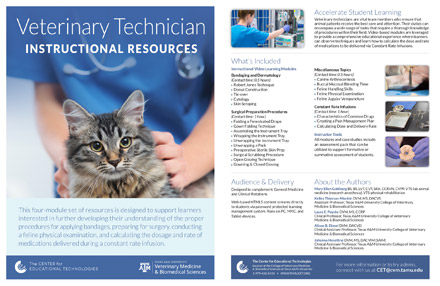Veterinary Technician Instructional Resources
Specialty: General Medicine
Species: Canine, Feline
AAVMC Standards: 1.3
Institutional Licensing Available: $1,800/unlimited users
Veterinary technicians are vital team members who ensure that animal patients receive the best care and attention. Their duties can encompass a wide range of tasks that require a thorough knowledge of procedures within their field. Video-based modules are leveraged to provide a comprehensive educational experience where learners can observe techniques and learn how to calculate the dose and rate of medications to be delivered via Constant Rate Infusions.
With an approximate contact time of 3 hours, the Veterinary Technician Instructional Resources includes the following:
Learning Modules:
Module 1 - Bandaging and Dermatology
(Contact Time: 0.5 hours)
This module contains instructional videos on the following topics:
- Robert Jones Technique
- Donut Construction
- Tie-over
- Cytology
- Skin Scraping
Module 2 - Surgical Preparation Procedures
(Contact Time: 1 hour)
This module includes a series of 10 instructional videos explaining proper procedure for surgery preparation. Specific topics include:
- Folding a Fenestrated Drape
- Gown Folding Technique
- Assembling the Instrument Tray
- Wrapping the Instrument Tray
- Unwrapping the Instrument Tray
- Unwrapping a Pack
- Preoperative Sterile Skin Prep
- Surgical Scrubbing Procedure
- Open Gloving Technique
- Gowning & Closed Gloving
Module 3 - Miscellaneous Topics
(Contact Time: 0.5 hours)
This module includes video instruction on the following topics:
- Canine Arthrocentesis
- Buccal Mucosal Bleeding Time
- Feline Handling Skills
- Feline Physical Examination
- Feline Jugular Venipuncture
Module 4 - Constant Rate Infusions
(Contact Time: 1 hour)
This module includes video-based instruction on the following topics:
- Characteristics of the drugs commonly delivered via CRI for pain management
- Creating a pain management plan (including combinations of drugs) for a patient
- How to calculate the dose and rate of medications to be delivered via CRI (in both a syringe pump and fluid bag)





